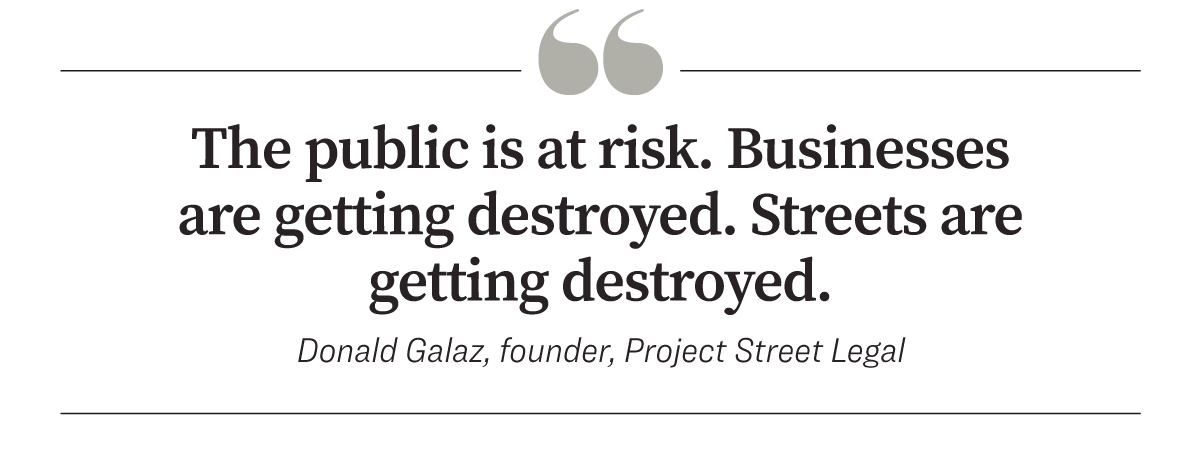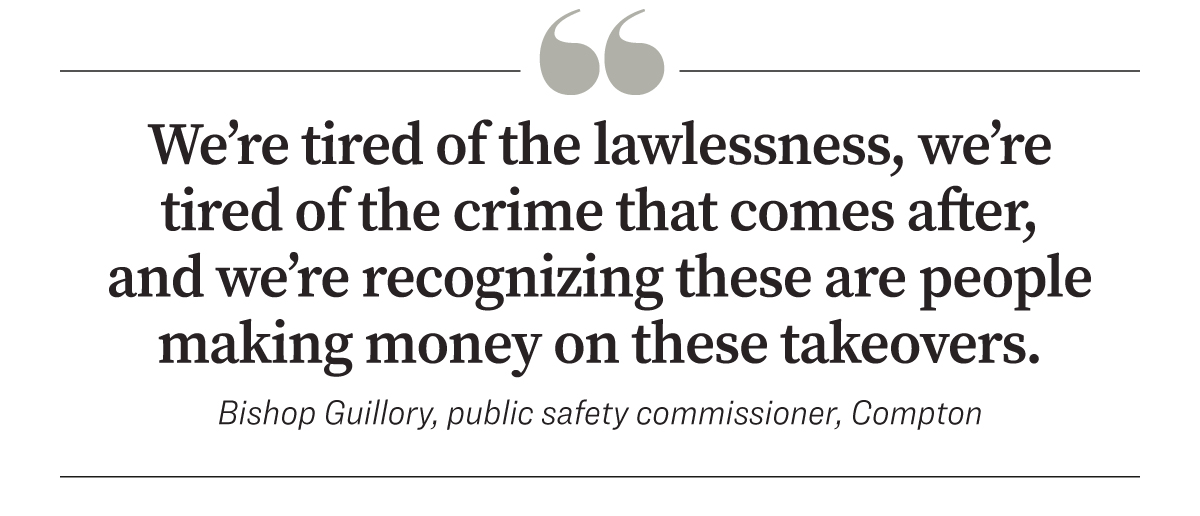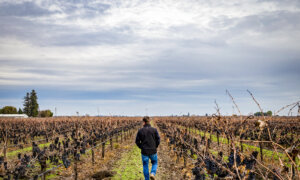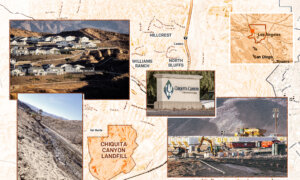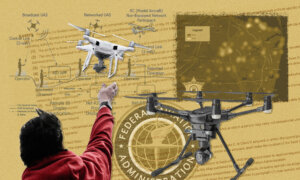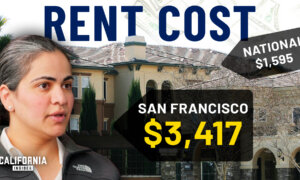LOS ANGELES—Two infernos, a vandalized storefront, drones spitting fireworks at drifting, souped-up muscle cars—relatively, it was a tame Labor Day weekend in Los Angeles County, where illegal street takeovers by racers seeking internet clout continue to terrorize neighborhoods.
Contemporary “takeovers”—in which drivers commandeer intersections and perform dangerous stunts for a scrum of onlookers—are a successor of sorts to California car cultures including drag racing, cruising, lowriding, and sideshows.
But propelled by the manic, mimetic spectacle of social media, they have become a uniquely dangerous part of the landscape.
Assaults, shootings, flash mob robberies, and pedestrian injuries associated with illegal racing and takeovers are all on the rise, according to law enforcement agencies, which say they are cracking down with a zero tolerance approach. A multi-agency task force is dedicated to addressing these crimes, and authorities are investing in educational programming and diversion, enhanced technologies, and street modifications at problem intersections.
Despite all of this, the problem appears increasingly unhinged.
“What we’re seeing is this increase in violent behavior—looting, cars on fire. Recently, we had two kids shot and one murdered at a takeover, at a spin,” Craig Valenzuela, commander of the Los Angeles Police Department’s (LAPD) Traffic Group, told the Los Angeles County Board of Supervisors at a July 30 meeting.
He was referring to a July 22 incident in which two 15-year-olds involved in a takeover were shot after an alleged robbery, which included one fatally.
“That’s really what concerns us—it’s the level of violence and us trying to get in there to end those and keep our communities safe,” Valenzuela said.
At the meeting, other agencies and county staff presented a final report on illegal racing and takeovers in unincorporated county areas that was nearly a year in the making.
They painted a rather bleak picture, acknowledging the scope and scale of the problem and the fact that existing enforcement, as well as outreach efforts by authorities—seeking to influence the behavior of an anti-authority youth subculture—are not working.
“It has risen to that level where we really need to dedicate all of our resources and address this epidemic that’s wreaking havoc on our communities,” LA Assistant Sheriff Myron Johnson told the board.
Supervisors ultimately voted to direct staff and the Los Angeles County Sheriff’s Department (LASD) to report back on funding and an action plan in 60 days.
To advocates who have been lobbying for years to stave off the inevitable casualties of illegal racing and takeovers it seems a long time coming.
“Unfortunately, I think it caught everyone by surprise,” Lili Trujillo Puckett, founder of Street Racing Kills, said, referring to a surge of takeovers during the COVID-19 pandemic.
Puckett founded her organization after her 16-year-old daughter, Valentina, was killed in a street racing crash in 2014. She now runs diversion programs for youth offenders, as well as legislative and education campaigns.
“There were no laws in place. I started asking for bills a long time ago, but nobody saw it was a problem,” she told The Epoch Times.
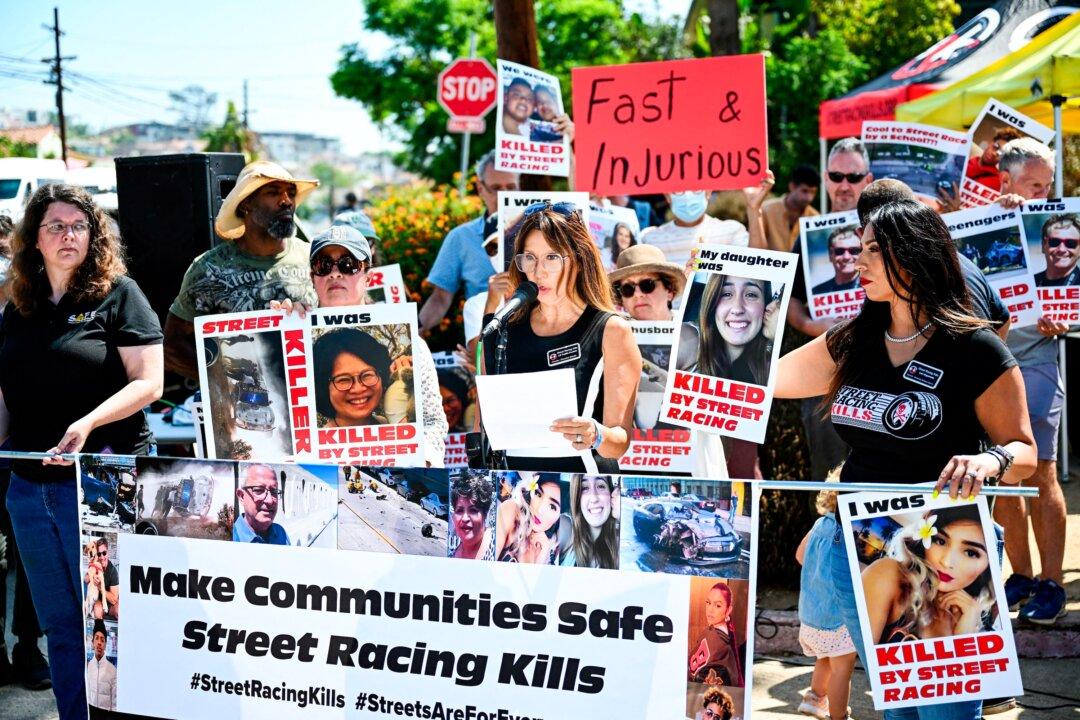
Lili Trujillo Puckett, founder of Street Racing Kills, speaks alongside local residents and supporters of the group during a protest on the increase in street racing takeovers in the Angelino Heights neighborhood of Los Angeles, on Aug. 26, 2022. (Patrick T. Fallon/AFP via Getty Images)
Donald Galaz, founder of Project Street Legal, an organization focused on providing legal venues for street racing, said the problem has outgrown law enforcement’s ability to corral it.
“It’s just way out of control,” he said. “No task force is ever going to stop it—there are too many individuals, these kids out there, they just continue to move from place to place.”
Galaz is a longtime member of the Brotherhood of Street Racers, a group that developed legal avenues for racing, which he credits with getting him off the streets and out of gangs in his youth. And while there is a “level of disrespect” and chaos in today’s takeovers that wasn’t part of the covert sideshows and drag racing of previous decades—then largely confined to industrial areas and parking lots—he says officials could still put a major dent in the problem by giving kids a safer alternative.
“I’ve been advocating for this for over 12 years—let’s do something. I’ve been through many city council members and mayors that promise to help,” he said.
Galaz said he ran phone banks for a mayoral campaign, but the effort ended in a long line of “unkept promises” to address the issue.
“In the meantime, people are dying. The public is at risk. Businesses are getting destroyed. Streets are getting destroyed,” he said. “And then you see on the news all the time that people are getting killed, and still elected officials have done nothing.”
Uneven Impact
The destruction tends to be concentrated in certain areas, and often perpetrated by people who live elsewhere, according to law enforcement officials.The city of Compton has long been an epicenter of Southern California car culture, home to motorcycle and racing clubs, and a Sunday lowrider cruise that continues to this day.
But in recent years, it has also become a hotbed for out-of-towners in search of street cred and Instagram likes, a launching pad for drivers to make their name.
“If you want internet clout, you have to go to Compton,” Galaz said. “That’s no secret.”
During a July 28 takeover in the city, California Highway Patrol (CHP) arrested 63 spectators, issued 66 citations, and impounded 28 vehicles, according to the agency. Those arrests represented only about 5 percent of participants—and about 80 percent were not residents of LA County.
Recent LASD data show the vast majority of takeovers in the first quarter of this year—219 out of 289—happened in the county’s Second Supervisorial District, which includes South LA and parts of the Harbor Region. Most of those were in the cities of Compton and Carson, which had 90 and 109 incidents, respectively. This is an increase over the previous quarter, when there were 173 takeovers in the District, out of a total 234 incidents, with 74 and 58 in Compton and Carson.
Meanwhile, the Fourth and First Districts, which cover the southeastern and eastern parts of the county, had 55 and 15 incidents in the first months of 2024. There were no takeovers reported in District Three, which includes West LA cities, or District Five, which covers the northern part of the county.

Vehicles drive over tire skid marks from other drivers doing
“The increase in illegal street takeovers is deeply troubling,” Compton Mayor Emma Sharif told The Epoch Times. “It goes against the values of our city—it really does. This issue has had a severe impact on our community, affecting both the safety and the well-being of residents.”
Both Compton and Carson do not have their own police forces but contract with the LA County Sheriff’s Department, which coordinates with other agencies such as the CHP on traffic enforcement. Carson city officials did not respond to a request for comment.
Looking at LAPD data for the city of Los Angeles, it appears that street racing and takeovers peaked in 2020, with 912 incidents. There were 319 in 2019, and the numbers have fluctuated since, dropping to 482 last year.
That shows redistribution, not eradication, according to observers.

“Just because it has peaked in the city of Los Angeles doesn’t mean it’s gone down across the county,” Damian Kevitt, executive director of the nonprofit Streets Are for Everyone, told The Epoch Times.
As the LAPD’s street racing task force has gotten more aggressive, he said, the crackdown has pushed the problem to outlying communities such as Compton and unincorporated areas.
The CHP, which enforces the vehicle code in Los Angeles County, responded to 100 street takeovers, issued 2,000 citations, arrested 500 people for reckless driving, driving under the influence, spectating, and weapons offenses, and impounded more than 400 vehicles in unincorporated areas of LA County last year, according to the agency.
“Street racers will show up, do their takeovers, spend 45 minutes—they know how long it will take for the task force to do their thing, then they’re off to the next location,” Kevitt said.
LASD and LAPD data show that takeovers increased in the first months of 2024 in both the county and the city, but the county saw an overall 15 percent dip in the second quarter over the first, from 289 to 245 incidents, LASD officials told the board at the July meeting.
That’s still more than in the fourth quarter of 2023, and Compton is trending upward.
‘More Brazen, More Violent’
In its June 12 report responding to a directive from the city council, the LAPD pointed to the diminishing ability of law enforcement officers and first responders to intervene at takeovers, which often include hundreds of spectators and countless vehicles.Spectators use laser pointers to blind officers and helicopter pilots, launch fireworks at police, intentionally ram and swarm cars, and resist arrest.
“I think they feel like they’re untouchable,” Galaz said. “And because it’s one police unit with two officers that shows up, they’re outnumbered right off the bat. So now you’ve got these kids that are out there blocking the cars, throwing rocks and bottles, and shooting fireworks, and doing that type of stuff to the police. ... They just don’t care.”
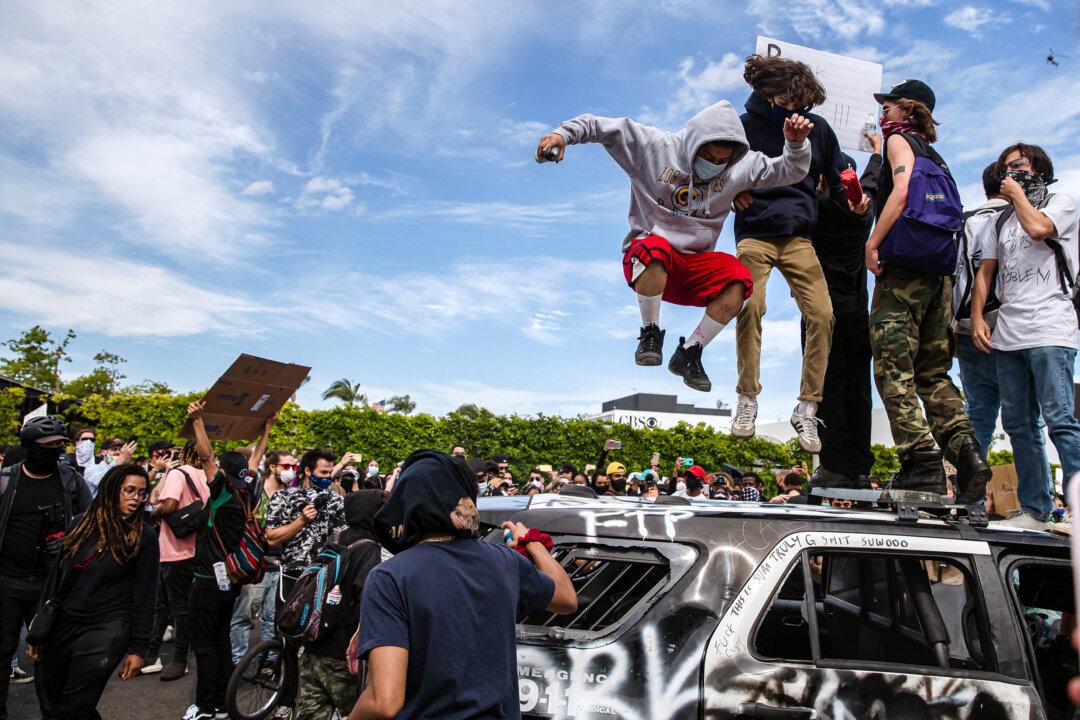
Demonstrators jump on a damaged police vehicle during a protest in Los Angeles on May 30, 2020. (Ariana Drehsler/AFP via Getty Images)
Street racing has always been anti-authoritarian, but Galaz noted that racers used to be more concerned with demonstrating their skills than with taunting law enforcement.
“The last thing we wanted to do was get the attention of law enforcement while we’re out trying to get something done, you know? But it seems like they’re taunting them,” he said. “I don’t understand the logic behind wanting to do these things and just the amount of disrespect.”
Law enforcement and first responders are already stretched thin by budget deficits, understaffing, and an all-consuming homelessness crisis. For all of these reasons, agencies are looking to outsource some policing to technology.
“We’re not going in the center of the takeover anymore. It’s just too dangerous for us,” CHP South LA Commander Joe Zivi told the board in July. “There is no doubt these takeovers are more brazen, more violent.”
The CHP already monitors hotspots with helicopters and airplanes equipped with infrared technology and recording equipment that can be used for prosecution, and soon it will have high-powered cameras to read license plates in real time, which authorities hope to bring to judges to get 30-day seizures, and then impound the vehicles at a later date, Zivi said.
Meanwhile, LASD hopes to expand a pilot program that uses drones to help with racing and takeover enforcement, while some cities are initiating their own programs.
In March, Carson debuted a new drone policy to “enhance city services,” and in April, it announced the installation of a multimillion-dollar, “state-of-the-art” surveillance system across the city to help “reduce suspicious activity” and increase stolen vehicle recovery as part of LASD’s License Plate Recognition Camera Project.
But some question the logic of investing in high-tech cameras to photograph license plates when many of the cars involved are stolen—and the drivers may be long gone by the time police show up.
Culture Clash
For older generations in racing and cruising scenes, contemporary takeovers and their attendant chaos are casting a long shadow.“I think the car culture has been, and still is, under attack from different angles,” Galaz said. “People will say law enforcement is just taking the fun out of things. But then the takeovers are giving a black eye to the whole culture.”
Developed by Mexican Americans in the post-WWII era, lowriding is a beloved and recognizable part of the Southern California cultural mosaic, memorialized in art exhibitions, books, films—and now imitated by adolescents with disposable income in places such as Saudi Arabia.
Last year, Gov. Gavin Newsom signed a bill legalizing lowriding and cruising—or driving “low and slow” to show off modified classic cars, overriding previous restrictions.
At the July 30 board meeting, public speakers from racing and lowrider clubs came out to remind the government that cruising is legal and should not be painted with the same brush as illegal takeovers.
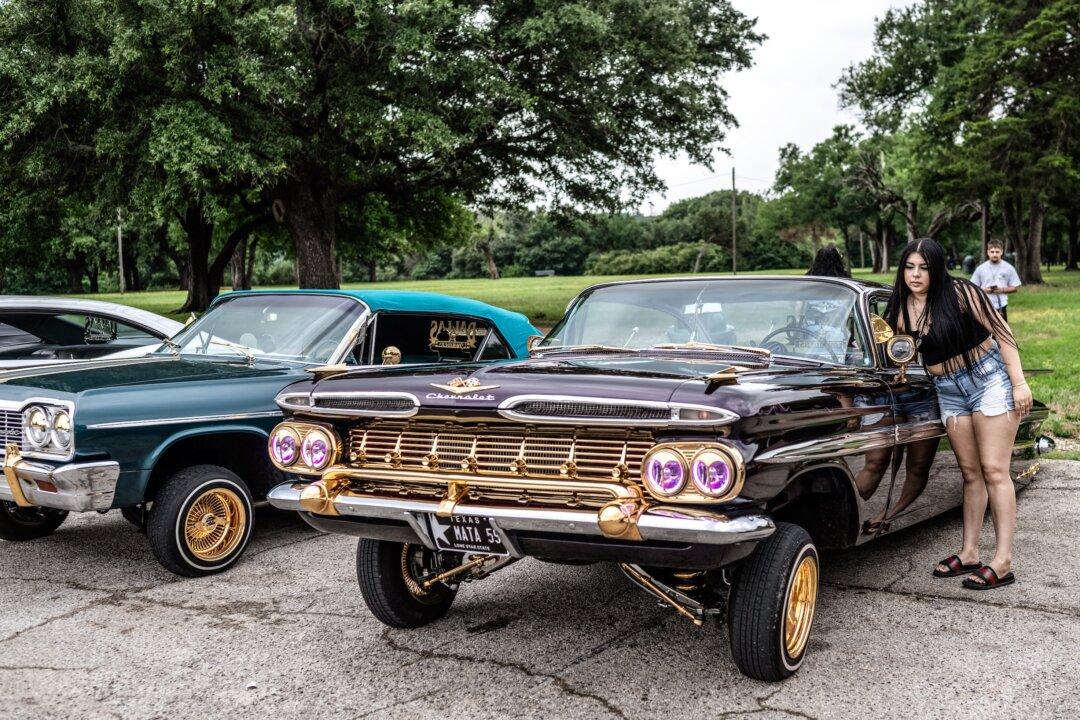
Mariah Mata (R), daughter of Dallas Lowriders spokesperson Mark Mata, starts a car in Kiest park in Dallas on June 2, 2024. (Andrew Caballero-Reynolds/AFP via Getty Images)
“Car club leaders are already self-policing organizations, and we’re trying to do our best to make our streets safe,” Art Limon, founder of the LA Lowrider Alliance, told the board. “We’re responsible drivers obeying the rules of the road. We do not support illegal takeovers.”
Other speakers requested language related to “cruising” be removed from the report, and that a clear line be drawn between legal lowriding and illegal takeovers. “The art of lowriding and the culture of cruising should not be in the report or be part of any ordinance related to illegal sideshows,” one person said.
Among younger racing enthusiasts, Kevitt suggested that “The Fast and the Furious” franchise, which first premiered two decades ago, is a more powerful influence than vintage car culture.
He pointed to research showing car violations spiking when new films are released, and to an increase in traffic fatalities in Los Angeles because of speed, drugs, and alcohol.
“We know that drug and alcohol use has gone up significantly since COVID. We know the number of hit-and-run fatalities skyrocketed,” Kevitt said.
Amid a spike in takeovers during the COVID-19 pandemic, Trujillo Puckett said, “people found a sense of community. Some of them come from broken homes. They found each other and a sense of family—and unfortunately, it turned into something so catastrophic.”
Weak Laws, No Deterrence
In early February, the Los Angeles City Council approved a pilot program to install street modifications—raised, hardened center lines, meant to curb takeovers—at 20 “problem” intersections.Just days later, the LAPD announced the arrest of Erick Romero Quintana, a 20-year-old from Paramount, believed to be one of the most prominent takeover organizers in the Southland.
“With over 70,000 followers on social media, this organizer has coordinated events throughout Southern California that have not only resulted in large-scale takeovers but also smash-and-grab robberies, vehicle thefts, and other violent crimes including murder,” the LAPD said in a statement at the time.
Shortly after his arrest on suspicion of conspiracy, authorities released Quintana.
Asked more than seven months later whether charges had been filed against the suspect, the LA County District Attorney’s Office told The Epoch Times, “A case remains under review.”
At a Jan. 24 news conference announcing the arrest of multiple juveniles involved in several different incidents, including the looting of a bakery in which participants drove a car through the front of a store in Compton, following a street takeover, the sheriff struck a hardened tone.
“We’re gonna get you,” LA County Sheriff Robert Luna said at the conference. “It may take a couple of days, you might get cocky and think, ‘I’m gonna commit another crime.’ We’re gonna get you.”
Following the string of violent incidents, Compton’s Public Safety Commission recommended stronger penalties, including 30-day car seizures, $10,000 fines, and arrests for reckless driving.
“We’re tired of the lawlessness, we’re tired of the crime that comes after, and we’re recognizing these are people making money on these takeovers,” Public Safety Commissioner Bishop Guillory told the city council at the time.
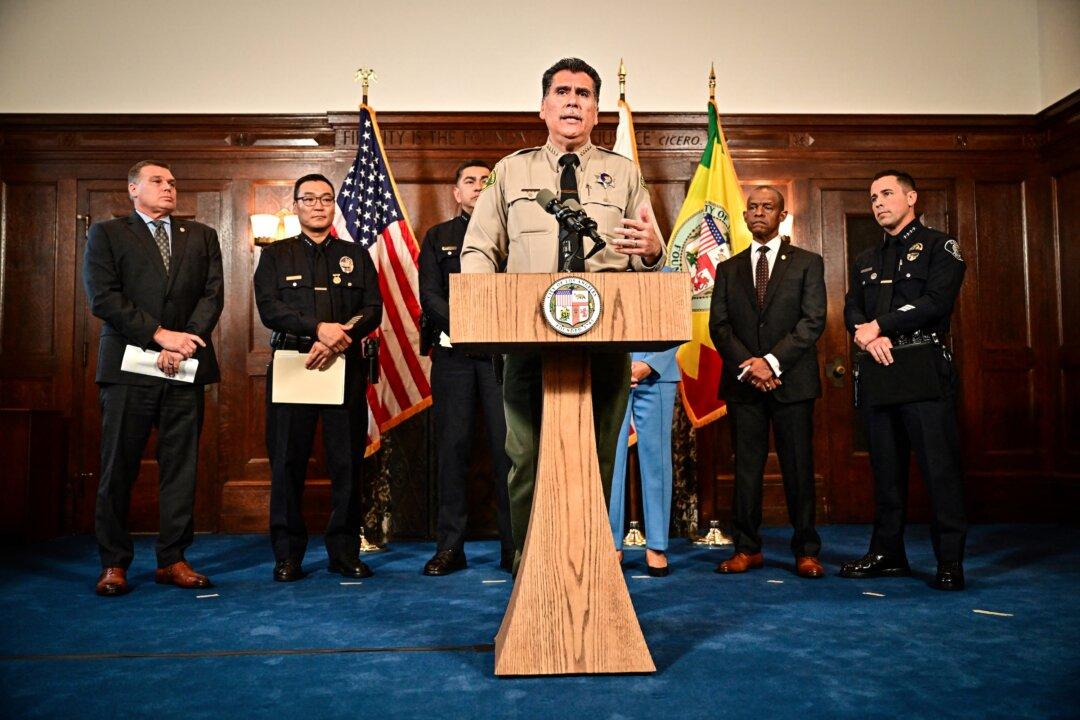
Los Angeles County Sheriff Robert Luna speaks during a news conference to announce new efforts to curb recent retail thefts, at City Hall in Los Angeles on Aug. 17, 2023. (Frederic J. Brown/AFP via Getty Images)
The city changed its ordinances to increase fines for spectating from $1,000 to $2,000, which officials hope to use to offset the costs of response and repairs.
“That may be something that will work, because a $2,000 fine can be rather damaging when it comes to having your car towed and trying to get it out, plus having to pay that fine,” Sharif said.
But throughout LA County, there is often distance between enforcement and prosecution.
In the June report, the LAPD offered an exhaustive review of current laws—and concluded that they are woefully inadequate.
“Current legal remedies have had minimal deterrent effect and are not sufficient to adequately combat these crimes,” the report stated, pointing to existing laws that prosecute speeding and reckless driving only as low-level misdemeanors with a negligible fine, and a lack of available enhancements.
The fact that such offenses are eligible for pre-conviction diversion, amounts to “completely circumventing any meaningful deterrent effect,” the LAPD stated.
When law enforcement refers such cases to the district attorney, a deputy district attorney will review and choose to file charges or refer to Street Racing Kills’s pre-filing diversion program.
“Right now, if they’re arrested and given a ticket, they have to take a class with me,” Trujillo Puckett said.
But in 2020, LA District Attorney George Gascón issued a special directive instructing deputies to decline or dismiss misdemeanor charges, including driving with a suspended license or without a valid one.
Law enforcement agencies rely on the California Vehicle Code to enforce street takeovers, including prohibitions of speed, or “aiding and abetting” a street race, or reckless driving. These can be charged as a misdemeanor or infraction and don’t trigger restriction or suspension of a driver’s license. A defendant charged with a misdemeanor could face a maximum of 90 days in jail, but such is rarely if ever imposed.
“The goal of this new policy is to reimagine public safety and best serve the interests of justice and community well-being,” Gascón wrote in the 2020 memo, stating prosecution of low-level offenses will now be governed by this “data-driven” reform policy.
Without “meaningful” laws that have consequences, the LAPD states in the June report, “participants and spectators engage in these activities knowing that law enforcement and the judicial system will avoid punishing their reckless and illegal activities.”
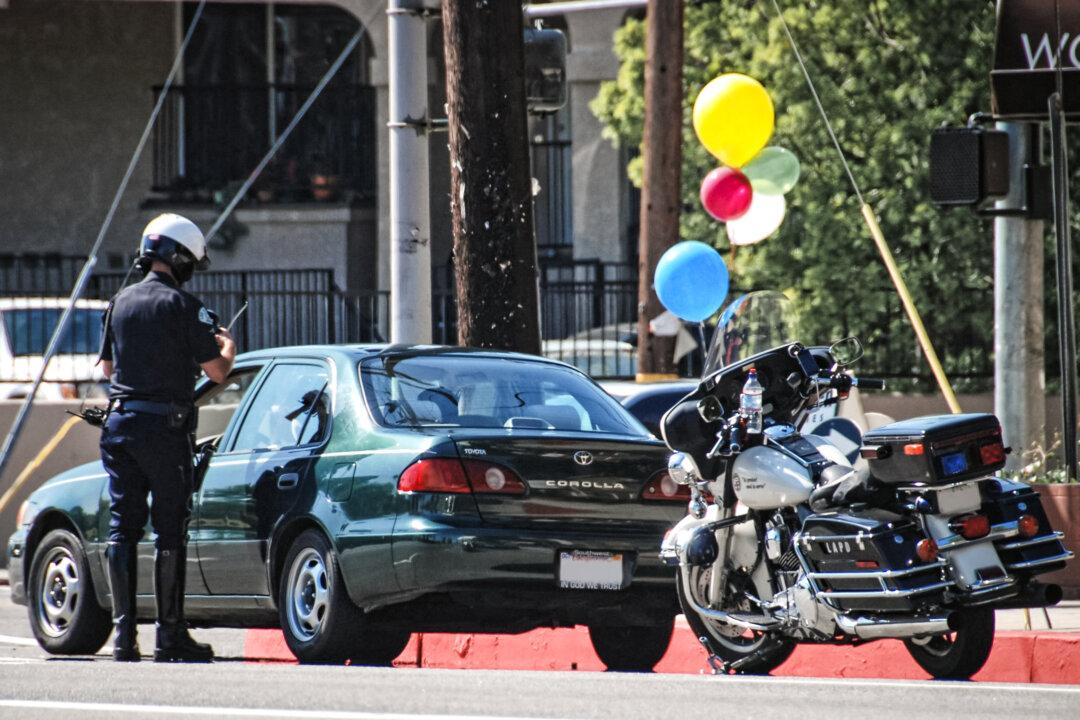
A Los Angeles Police Department officer stops a vehicle in the Arleta neighborhood of Los Angeles, in this file photo. (Chris Yarzab/Flickr)
The result, they say, is increasing hostility toward first responders and an overall culture of fear and intimidation in impacted neighborhoods.
Under state law that takes effect next July, authorities can suspend licenses for up to six months for speeding as part of a sideshow or street takeover.
But the LAPD concluded that suspensions have “minimal punitive and deterrent effect,” as the DMV issues “countless” citations to unlicensed, suspended or revoked drivers, “yet the problem persists.”
The LAPD identified DMV codes that allow 30-day impounds, with or without a warrant, as among the most effective tools to thwart takeovers, and the addition of technology such as high-powered cameras is meant to build on that.
But police are not allowed to seize and destroy “nuisance” vehicles engaged in illegal contests and speeding because the city suspended several provisions because of “constitutional concerns.”
The LAPD requested that the city council reconsider multiple code amendments, first proposed in 2022 but not implemented, and urged the council to adopt a resolution to strengthen state laws and declare sideshows and takeovers public nuisances.
Social Media
Law enforcement monitors popular social media accounts, and the county has identified several top takeover influencers who typically post about 20 videos monthly, each often garnering tens of thousands of likes.Popular hashtags include #getbackorgetsmacked, and videos abound with spectators who get too close. Others show cars continuing to do “doughnuts” around police that have pulled into the middle of a takeover, the torching of vehicles, or the conducting of drone pyrotechnics.
In an attempt to counter the phenomenon, LA’s multiagency street racing task force has maintained its own Instagram account since 2016, where it does its best to troll participants. Photos of seized cars on flatbed trucks, confiscated guns, and vehicle infernos are accompanied by warnings such as “Swung it and lost it for 30 days,” “Car destroyed, trip to jail, and a long walk home,” and “Passengers got a little something as well. Spectating is illegal too.”
Whether or not local governments will seek provisions that pressure social media platforms to remove content is unclear.
At the July supervisor meeting, county CEO Fesia Davenport recognized that this would be a First Amendment issue and said, “I’m not suggesting we take down these Instagram posts, but we need to respond in kind when trying to capture the imagination of the population.”
Supervisor Holly Mitchell, however, pushed for a stronger response.
“When I look at the testimony before Congress, with people holding social media engines accountable for dangerous actions, I don’t know why we wouldn’t when we can chronicle and identify the loss of life—not just property but deaths as a result of these actions,” she said.
Mitchell’s office did not respond to a request from The Epoch Times asking her to expand on her views.
The county’s July report stated that “working with social media to censure posts is beyond the scope of this report,” as removal of social media posts involves First Amendment protected speech, but noted that the county counsel will address the issue in a privileged and confidential board report.

Posters of street racing offenders and victims are displayed next to race cars in Santa Ana, Calif., on April 29, 2022. (John Fredricks/The Epoch Times)
Solutions: This Would ‘Put a Dent in It’
Beyond expanding and enhancing law enforcement, David Carroll, the LA County Department of Youth Development director, said any solution will need to provide opportunities for would-be thrill seekers.“You can’t arrest and fine your way out of it,” Carroll told the board of supervisors in July, expressing concern for several-thousand-dollar spectator fines, which for a young person “might as well be $1 million.”
He said young offenders go to takeovers because “it’s something to do,” a place where people seek community, recognition and admiration. “And there is an adrenaline rush,” Carroll said.
Galaz likewise argues that you can’t beat that out of people, and it’s wrong to enforce the laws without providing somewhere else to go.
“They want to see something that’s going to draw them in. People love horsepower. People want to see cars spinning like that,” he said.
All of these self-taught kids tuning their cars with laptops, Galaz said, could be the next generation of mechanics, aviation techs, and videographers if they had the right guidance.
In its July report to the board of supervisors, LASD said engagement with participants “has revealed limited interest in using safer alternatives” such as the Irwindale Speedway or several others that already exist in the region.
Since first visiting with his father and uncle as a child, Galaz has watched the track at Terminal Island—between the neighborhoods of Wilmington and San Pedro—open and close nearly a dozen times. Reopening, he said, would fill the need for a space near takeover hotspots such as Carson and Compton.
But some doubt that reopening the track would have any impact on what is essentially a culture threaded around lawlessness and crime.
“This idea of opening the track on Terminal Island, the people that go to these, they’re not going to want to pay to upgrade their cars legally to go [there],” one Compton resident at the July board meeting said.
“They’re not going to be happy sitting on the stands, watching donuts—no, they want to be at the intersections, that’s the thrill, breaking the law, committing these crimes and being in the middle of the intersection.”
Galaz disagreed.
“It will put a big dent in it. I’m real confident with that—I know, because it worked for me in the ‘90s,” he said, referring to when the raceway reopened from 1993 to 1995.
“Big Willie” Robinson, founder of the Brotherhood of Street Racers, originally opened the track in the 1970s with the help of former LA Mayor Tom Bradley.
“There was nobody out on the streets to race anymore. Everybody was at the track. Why race the street when you can go over to Terminal Island and race out there? That worked for us,” Galaz said.
Social media, he contends, would “spread it like a wildfire,” and racers with name recognition would bring people out—an intergenerational community united by the need for speed and deep love of the craft and professionalism that go into car culture.
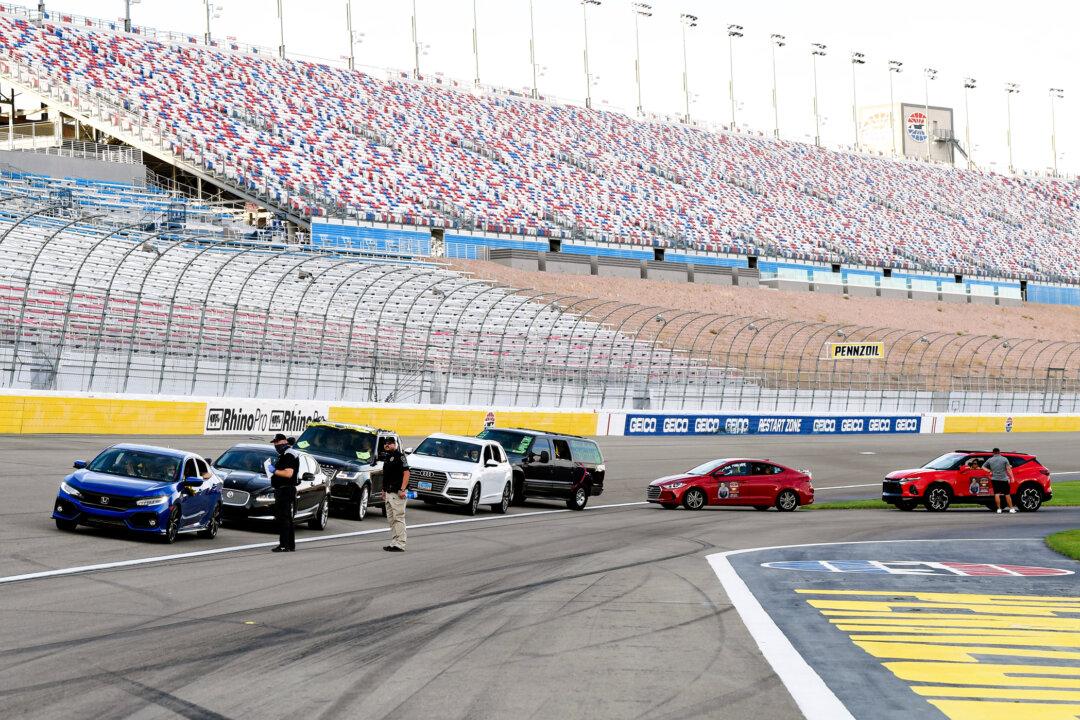
Graduating students and their families line up on a racetrack in vehicles during a commencement ceremony held at Las Vegas Motor Speedway in Las Vegas on May 22, 2020. (Ethan Miller/Getty Images)
“Big Willie used to say, ‘everybody’s infected from 8 to 80,’” he said. “I’m confident if there is a place that was open more than one day a week, you would get a good number of these individuals off the streets.”
But Galaz has been banging this drum for more than a decade, with frustrating results.
“I’m standing on the cliff saying, ‘hey man, don’t go over this cliff.’ And they just don’t care,” he said. “I don’t know why it’s taking the elected officials so long.” He points to endless reports, committees and roundtable discussions.
For Trujillo Pucket, the solution is stronger legislation, along with enforcement, education, and diversion.
In the past several years, a number of statewide bills targeting street racing and takeovers have passed—including Ryan’s law, which expands the list of crimes that qualify for felony manslaughter caused by hazardous driving, AB 3 and AB 2000, which allow courts to suspend licenses, and AB 645, which will install automatic speed ticketing cameras in six pilot cities, including Los Angeles.
Both Trujillo Puckett’s and Kevitt’s organizations worked with State Sen. Anthony Wiener on SB 961, which the Legislature passed in early September. Initial iterations would have required active speed governors, or speed-limiting devices, installed in new cars. But after facing opposition, subsequent amendments toned down the language and it would now require only passive governors—essentially a driver warning system.
In an email, Kevitt called the result a disappointment, given that speeding is the leading cause of “traffic violence”—meaning severe injuries and fatalities—across the United States.
Those reviewing the bill, he said, “were not ready to prioritize the right to life over the right for people to speed so we had to water the bill down to something that was more palatable—a single beep and visual warning when one starts to drive 10 MPH over the speed limit.”
Kevitt likened the effort to mandating seat belts in the early 1970s and DUI laws in the 1980s—a battle of personal freedoms versus life-saving restrictions.
“Seatbelts have since been credited with saving 500,000 lives, and most people would never drive without one. DUIs have gone down and tens of thousands if not hundreds of thousands of lives have been saved due to DUI laws being enforced,” he said.


